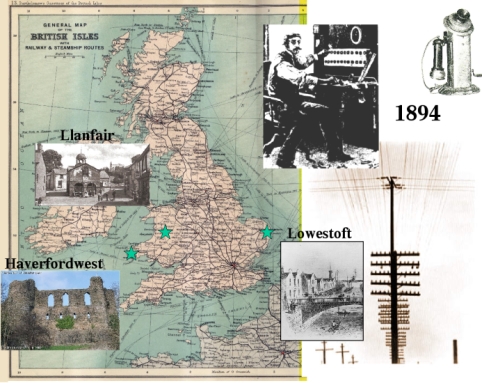Who Discovered it?
The story of the plasmasphere discovery started out as anecdotal. With the advent of the telegraph in the 1800s, telegraph operators would sometimes here a whistle or rumbling whilst transmitting to other operators. The sounds were attributed to problems with the wire or simply ignored. They were also associated with folklore. Many people only heard about these sounds and so thought they were simply myths.

In the 1890s, W. H. Preece, a telegraph manager, colaborated with the Astronomer Royal to legitimize the observations. Royal had data on the earth currents from recent magnetic storms. Preece told his telegraph offices to document each time they heard the sounds. There was a striking corelation with these sounds and the Aurora Borealis. Here are some of the operator comments:
- Mr. Donnithorne in Llanfair P. G., Anglesea, reports: "At 2.0 a.m. (Saturday) the telephone receiver was again tried, and then 'twangs' were heard as if a stretched wire had been struck, and a kind of whistling sound. The strength of the earth current was 17.7 mA".
- Mr. Miles, in Lowestrof, reports: "Noise at 408 wire seemed like that heard when a fly-wheel is rapidly revolving," and "sounds in telephone appear like heavy carts rumbling in the distance."
- Mr. Scaife, in Haverfordwest, reports: "March 31, 2.5 a.m. Earth currents on all wires; wires completely stopped... Peculiar and weird sounds distinctly perceived, some highly-pitched musical notes, others resembling murmur of waves on a distant beach?The musical sounds would very much resemble those emitted by a number of sirens driven at first slowly, then increasing until a screech is produced, then again dying away. Duration of each averaged about twenty seconds." (citation needed)
British soldiers heard similar sounds in their communication amplifiers while on the battle-field. You can imagine the feeling WWI British soldiers might get when they heard these sounds through their amplifiers. An incoming grenade can sound strikingly like these sounds, called whistlers, correlated with the Aurora Borealis.
Today we know that whistlers are radio frequencies produced by lightning. Theses radio waves travel away from Earth and then come back again- following the Earth's magnetic field lines. On the way back, they pass through the magnetosphere, the plasmasphere, and the ionosphere. The waves are highly dispersed (or change frequencies) as they travel thousands of kilometers by the magnetized plasma in the plasmasphere. The result is a musically descending tone that sounds like a whistle! More information on whistlers
In the 1930s, Burton and Boardman introduced the sound spectrograph to the scientific community. People started using it to study frequency dispersion since that's what gave the whistlers their unique sound.
By 1950, scientists knew there was an ionized layer at the top of Earth's atmosphere. They also knew it was produced easily by ultra-violet (UV) light from the Sun. It was thought that the atmosphere just fizzled out as distance from the Earth increased.
In 1952, L.R. Owen Storey found that whistler frequencies with even multiples had atmospherics while those with odd multiples had no atmospherics. This led him to the conclusion that there is plasma in Earth's atmosphere, and it guides these waves along Earth's magnetic field lines and disperses them.
However, there is a problem Storey's thesis. The ionosphere can only account for so much frequency dispersion. Yet, whistlers with far more frequency dispersions are measured.
Robert Helliwell, called the father of whistler research, contributed much to ground whistler research. He went to several locations and studied whistlers correlating them with geomagnetic storms. Scientists eventually discovered that there is a lot more plasma above the ionosphere than they had previously thought.
Don Carpenter also studied ground whistlers. In 1963, he found a sharp drop in frequncy dispersion about 3 Earth radii out or 12,000 miles away from Earth. This represented a sharp drop in plasma in that region. Around the same time, astronomer Konstatin Gringauz was also making measurements of the plasmasphere from the USSR space craft Luna 2. He also found a sharp drop in plasma density at 3 Earth radii out.
Scientists now call this the plasmapause; it represents the edge of the plasmasphere.
Web Links
NOAA's Space Weather Prediction Center - Today's Space Weather Updated Every 5-minutes
National Space Weather Program - The U.S. Government and Space Weather
Responsible Official: Dr. David McKenzie
Last Updated: May 27, 2015
